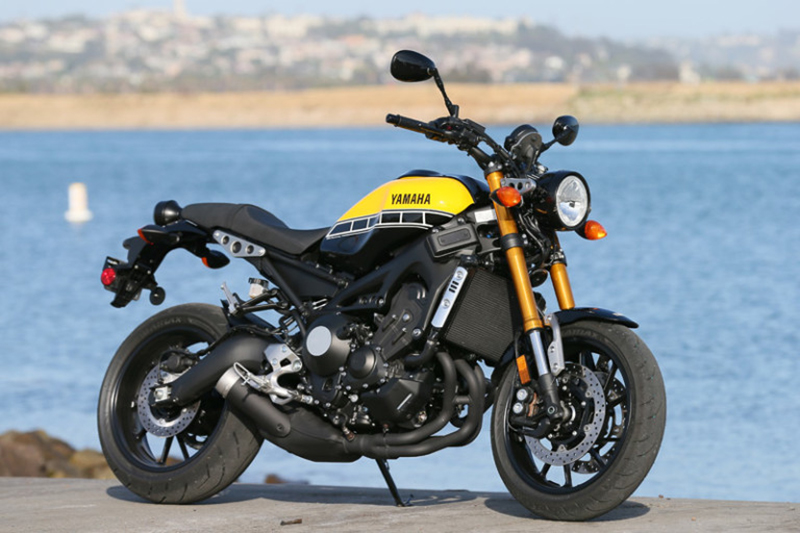2016 Yamaha XSR900

First Ride Review
Without a doubt, one of the most exciting engines to come along in the last couple of years is Yamaha’s 847cc in-line triple. Churning out more than 100 rear-wheel horsepower, it packs a punch and the “crossplane concept” design, with offset crankpins and even firing intervals, infuses it with a feisty blend of sound, feel and torque. The potent, versatile triple has powered three new models in as many years—the FZ-09 naked sportbike for 2014, the FJ-09 adventure sport tourer for 2015, and now the neo-retro XSR900 for 2016.
“Neo-retro” isn’t as oxymoronic as it may sound. Reaching back to Yamaha’s own XS750 triple from the mid-’70s for inspiration, designers gave the XSR900 a round headlight and a traditional-looking fuel tank with knee cutouts and hand-finished aluminum covers. Like the SR400 and Star Bolt C-Spec, the XSR900 is another model that Yamaha hopes will tap into the popularity of vintage-style bikes such as café racers, scramblers and trackers. Headlight supports, fender supports, radiator shrouds and side covers made of bare aluminum give the bike an elemental, hand-built look, and customizing the XSR is easy with accessories like an aluminum seat cowl, clubman bars, windshield and other bolt-ons.
Throwing a leg over the XSR900 at the press launch in San Diego, the bike felt both familiar and new. Atop the handlebar is a beautiful brushed aluminum plate with the Yamaha tuning-fork logo that holds the single meter offset to the right (as on the FZ-09), but it’s a round unit (as on the Star Bolt) with a unique, very modern white-on-black display that’s packed with information. Like the FZ-09, the 3.7-gallon tank and seat are narrow, but the XSR’s seat is slightly taller—32.7 inches vs. 32.1 on the FZ—and positions the rider 2 inches farther back. The handlebar and footpeg positions are the same on both bikes, so the XSR puts the rider into a more aggressive, forward-leaning posture.
Hitting the starter and blipping the throttle brought music to my ears—the rambunctious growl of the quick-revving triple. Like the FZ-09 and FJ-09, the XSR900 uses the Yamaha Chip-Controlled Throttle (YCC-T) throttle-by-wire system and has D-Mode, with A, STD and B modes that adjust throttle response and engine output. As I would soon find out, embarking on a 130-mile test ride on back roads and city streets, the herky-jerky throttle response that plagues the FZ-09 and FJ-09 is also a problem on the XSR900. Throttle response is particularly abrupt in the sport-oriented A mode, but even in the other modes it presents challenges at low speeds and when trying to incrementally roll on or off the throttle mid-corner. What’s most perplexing about the XSR’s erratic throttle response is that I had just put 4,000 miles on Yamaha’s FJR1300ES, which uses the same YCC-T system yet has very precise and predictable throttle response in both of its modes (Sport and Touring).
As we learned with our FJ-09 long-term test bike, you can adapt to the throttle response over time. And you forget all about it when you’re on the pipe. Keeping the throttle open and the revs up is like drinking from the fountain of youth. It takes me right back to when I first experienced the pure adrenaline rush of speed on two wheels—that visceral sensation of power felt through the grips and seat, between the knees, white-knuckling the grips and balancing on a tightrope between fear and excitement. The triple feels raw and unfiltered, but not rough or unbalanced. Its personality shines right through but not at the expense of refinement. At highway speeds the engine hums right along, and the new assist-and-slipper clutch reduces effort at the lever and makes gear changes on the 6-speed transmission a breeze.
Like the FZ-09 and FJ-09, the XSR900 is light (430 pounds wet, claimed) and frisky. Pushing it through a tight set of curves requires little effort, and it responds immediately to even the smallest of steering inputs. The XSR900’s suspension setup uses dual-rate fork springs and higher compression and rebound damping rates than what’s found on the FZ-09, which gives it a firmer, more responsive ride that’s similar to the FJ-09 sport tourer. Triple-disc brakes, with dual radial-mount 4-pot front calipers and a 1-pot rear caliper, are strong and predictable, and ABS and two-level traction control are standard (TC can be turned off but ABS cannot).
It’s long been axiomatic that bikes with character have flaws. They don’t like to start or they don’t like to run, or when they do run they run too hot or vibrate too much. Dealing with such flaws is a way of paying your dues, earning the right to ride a cool bike. The Yamaha XSR900’s flaw is poor throttle response. You can work around the flaw by riding in B mode, which has the softest throttle response but also reduced power, or by using finesse. But it’s a small price to pay for a bike with such an awesome engine in a light and very stylish package. Unlike true vintage bikes, with the XSR900 you don’t have to worry about poor reliability or weak brakes or clapped-out suspension. Sure, there’s some vibration, but it’s the right kind of vibration—the sort that reminds you that you’re straddling a sucking, squeezing, banging, blowing device of combustion with the power of more than 100 horses.
Not only that, but the XSR900 is affordable. It costs just $9,490 in Matte Gray/Aluminum or $9,990 for 60th Anniversary Yellow, which comes with gold fork tubes, a yellow shock spring and anniversary badging. Power (and style) to the people.
